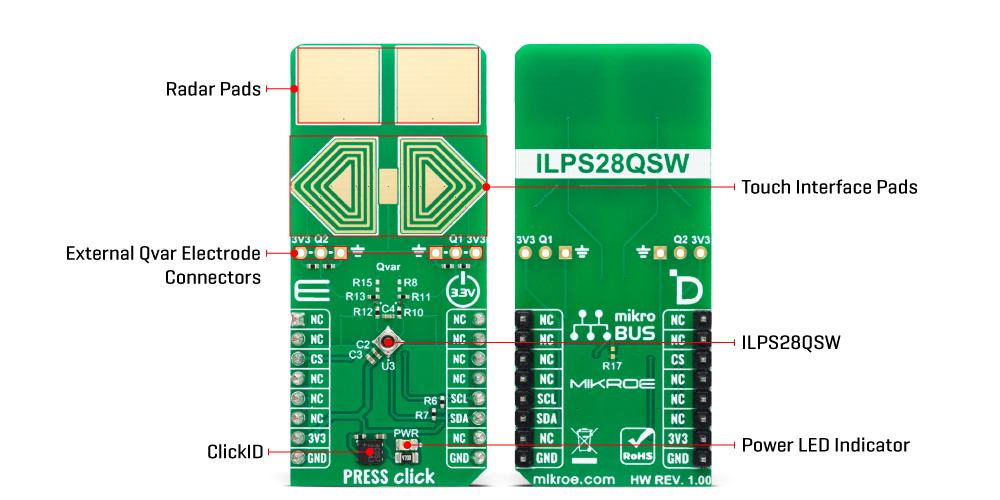OFF
GO LOCAL
| Company | Stock | Price |
|---|---|---|

MIKROE-5862
18 g
Status:
PRESS Click is a compact add-on board that contains a board-mount pressure sensor. This board features the ILPS28QSW, an absolute digital output barometer from STMicroelectronics. It is a dual full-scale sensor with a measuring range of 260 up to 4060hPa. In addition, it comes with a Qvar detection ability, which is an electric charge variation detection and is available on two pins. This Click board™ makes the perfect solution for the development of industrial applications, gas and water metering, weather station equipment, altimeters and barometers for outdoor devices, and more.
PRESS Click is fully compatible with the mikroBUS™ socket and can be used on any host system supporting the mikroBUS™ standard. It comes with the mikroSDK open-source libraries, offering unparalleled flexibility for evaluation and customization. What sets this Click board™ apart is the groundbreaking ClickID feature, enabling your host system to seamlessly and automatically detect and identify this add-on board.
This product is no longer in stock
Availability date:
OFF
| Company | Stock | Price |
|---|---|---|

PRESS Click is based on the ILPS28QSW, an absolute digital output barometer from STMicroelectronics. The sensor comes in a water-resistant package, and a metal lid can be easily sealed with an O-ring. It has two user-selectable modes that allow you to set a measuring range. As a main feature, the sensor integrates an analog hub sensing functionality to connect an analog input and convert it to a digital signal for embedded processing. It also integrates Qvar channels that can be enabled for sensing in applications such as water leak detection, tap, double tap, long press, and even a left-to-right and right-to-left swipe. The sensor has good accuracy, low-pressure sensor noise, low power consumption, and a 24-bit pressure data output.

The inner sensing element consists of a silicon membrane for MEMS pressure sensors. When pressure is applied, the membrane deflection induces an imbalance in the Wheatstone bridge piezoresistance, whose output signal is converted by the sensor's interface. The sensing element is designed to resist water pressure of up to 10ATM, while the potting gel protects electronic components from long-term exposure to harsh environments. The sensor is factory-calibrated, and the trimming values are stored in a non-volatile memory.
The sensor can work in several modes, such as Bypass, FIFO, Continuous mode, Continuous-to-FIFO, Bypass-to-Continuous, and Bypass-to-FIFO mode. There are 128 slots of 24-bit FIFO data to store the pressure output values, allowing consistent power savings as the host MCU does not need to poll data from the sensor continuously.
The PRESS Click allows you to use the Qvar functionalities of the sensor. There are two sets of pads. The upper pair can be used as a radar and is disabled by default. You can enable it by soldering two unpopulated R8 and R15 0ohm resistors. Two arrow-like pads are parts of a sensitive touch interface able to detect touch, press, or swipe. Two 3-pin headers allow you to attach external electrodes on the sensor's Q1 and Q2 Qvar channels. Those electrodes can be used for all the mentioned Qvar functionalities. PRESS Click uses a standard 2-Wire I2C interface to communicate with the host MCU. The I2C interface of the sensor supports Fast mode and I2C clock frequencies of up to 1MHz.
This Click board™ can be operated only with a 3.3V logic voltage level. The board must perform appropriate logic voltage level conversion before using MCUs with different logic levels. Also, this Click board™ comes equipped with a library containing easy-to-use functions and an example code that can be used as a reference for further development.
Type
Pressure
Applications
Can be used for the development of industrial applications, gas and water metering, weather station equipment, altimeters and barometers for outdoor devices, and more
On-board modules
ILPS28QSW - absolute digital output barometer from STMicroelectronics
Key Features
A dual full-scale absolute pressure sensor in a water-resistant package, an integrated analog hub for processing analog data input, integrated Qvar for detecting electric charge variation, low current consumption, good accuracy, integrated temperature compensation, Qvar pads, Qvar connectors, and more
Interface
I2C,I3C
Feature
ClickID
Compatibility
mikroBUS™
Click board size
L (57.15 x 25.4 mm)
Input Voltage
3.3V
This table shows how the pinout on PRESS Click corresponds to the pinout on the mikroBUS™ socket (the latter shown in the two middle columns).
| Label | Name | Default | Description |
|---|---|---|---|
| LD1 | PWR | - | Power LED Indicator |
| Description | Min | Typ | Max | Unit |
|---|---|---|---|---|
| Supply Voltage | - | 3.3 | - | V |
| Operating Pressure Range | 260 | - | 4060 | hPa |
| Absolute Pressure Accuracy | - | 0.5 | - | hPa |
| Pressure Data Output Resolution | - | 24 | - | bit |
We provide a library for the PRESS Click as well as a demo application (example), developed using MIKROE compilers. The demo can run on all the main MIKROE development boards.
Package can be downloaded/installed directly from NECTO Studio Package Manager (recommended), downloaded from our LibStock™ or found on Mikroe github account.
Library Description
This library contains API for PRESS Click driver.
Key functions
press_get_measurement_data PRESS gets the measurement data function.
press_get_ah_qvar_data PRESS gets the AH/Qvar data function.
press_sw_reset PRESS software reset function.
Example Description
This example demonstrates the use of PRESS Click board™ by reading and displaying the pressure, temperature and Qvar measurements.
void application_task ( void )
{
#if ( EXAMPLE_MODE == EXAMPLE_MODE_PRESS_TEMP )
example_pressure_temperature( );
#elif ( EXAMPLE_MODE == EXAMPLE_MODE_SWIPE_SENSING )
example_swipe_sensing( );
#endif
}
The full application code, and ready to use projects can be installed directly from NECTO Studio Package Manager (recommended), downloaded from our LibStock™ or found on Mikroe github account.
Other Mikroe Libraries used in the example:
Additional notes and informations
Depending on the development board you are using, you may need USB UART click, USB UART 2 Click or RS232 Click to connect to your PC, for development systems with no UART to USB interface available on the board. UART terminal is available in all MIKROE compilers.
This Click board™ is supported with mikroSDK - MIKROE Software Development Kit. To ensure proper operation of mikroSDK compliant Click board™ demo applications, mikroSDK should be downloaded from the LibStock and installed for the compiler you are using.
For more information about mikroSDK, visit the official page.
NOTE: Please be advised that any peripheral devices or accessories shown connected to the Click board™ are not included in the package. Check their availability in our shop or in the YMAN section below.